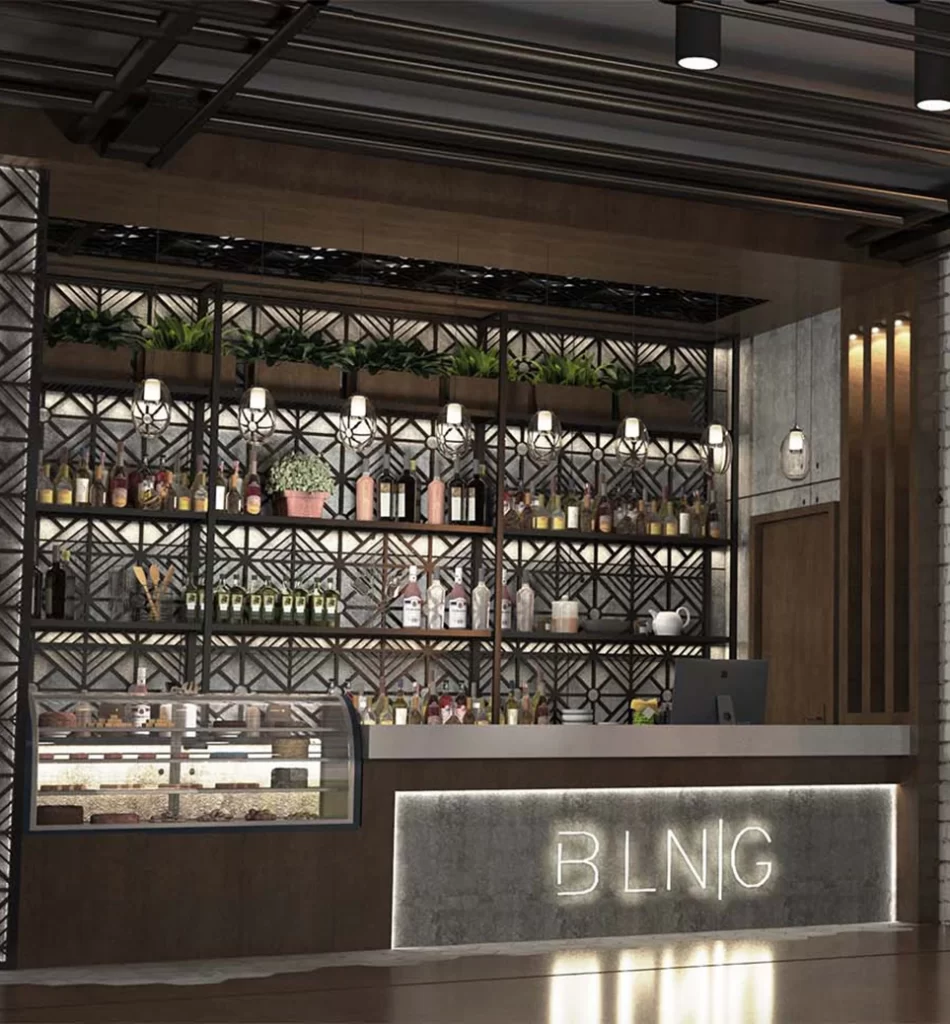An Expert Guide to Restaurant Interior Design Excellence: Crafting Unforgettable Dining Experiences

Table of Contents
Restaurant interior design plays a pivotal role in the culinary world, shaping not just the physical environment but the very essence of the dining experience.
It’s the art of harmoniously blending aesthetics and functionality within the four walls of a dining establishment.
From the moment patrons step through the doors, the ambiance crafted through restaurant interior design can make or break their dining experience.
It sets the stage, conveys a theme, and even influences diners’ emotions, enhancing the flavor of each dish.
In this article, we delve into the world of restaurant interior design, exploring its significance and how it profoundly impacts the cherished moments we spend in restaurants.
The Basics of Restaurant Interior Design
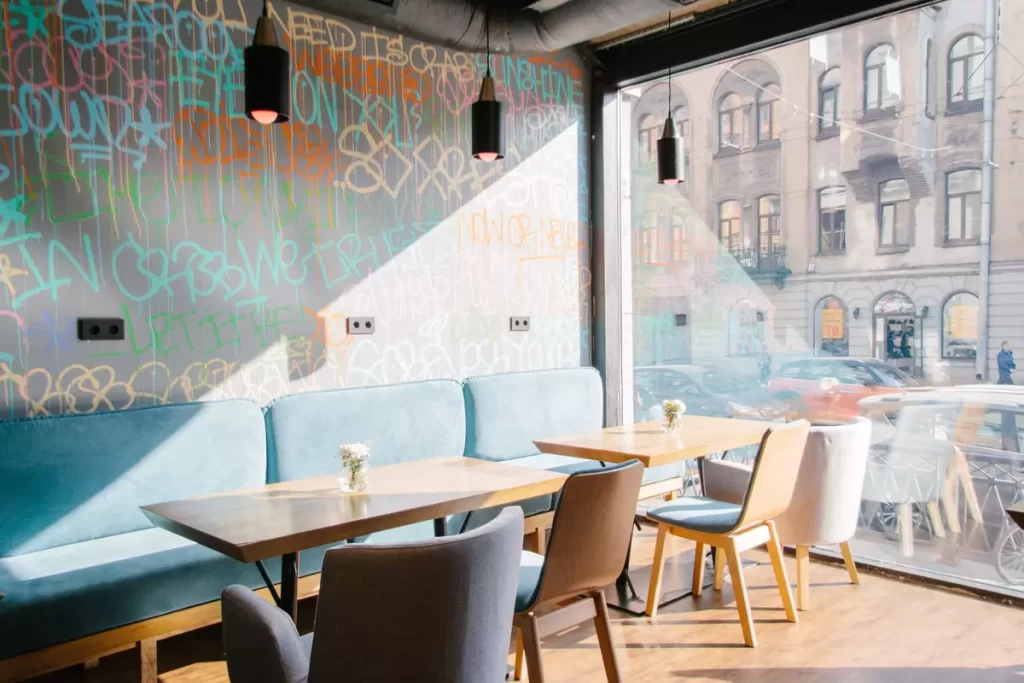
Restaurant interior design is more than just selecting color schemes and arranging furniture; it’s a strategic blend of aesthetics and functionality that transforms an empty space into a memorable dining destination.
Core Elements of Restaurant Interior Design.

Restaurant interior design is the art of creating an inviting, functional, and visually appealing space within a restaurant.
It encompasses a range of elements, including Layout and Flow, Furniture Selection, Color Palette, Lighting, Decor and Accessories.
We will deep into all these elements later in the article.
Balancing Functionality and Aesthetics
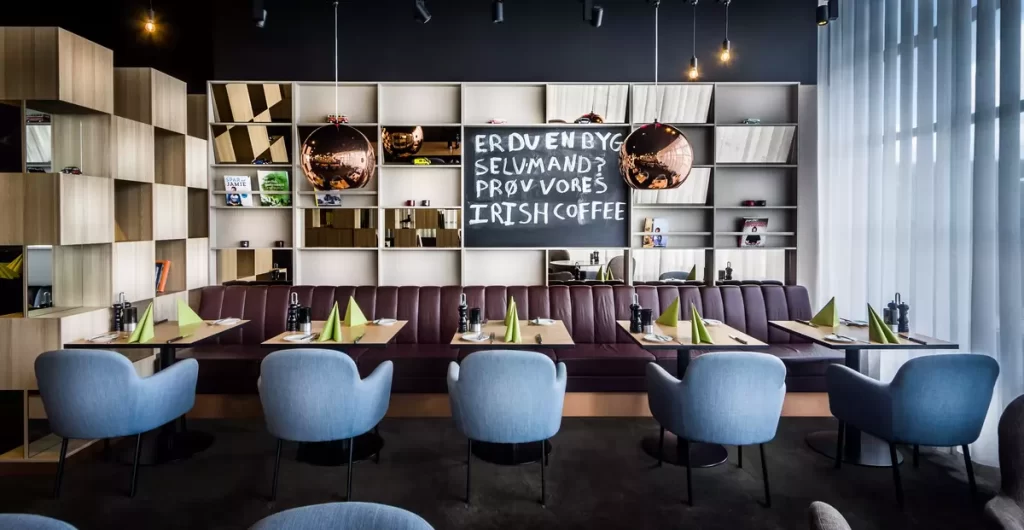
One of the fundamental challenges in restaurant interior design is finding the equilibrium between functionality and aesthetics.
While a visually stunning interior can attract patrons, it’s equally crucial that the design supports the practical needs of the establishment.
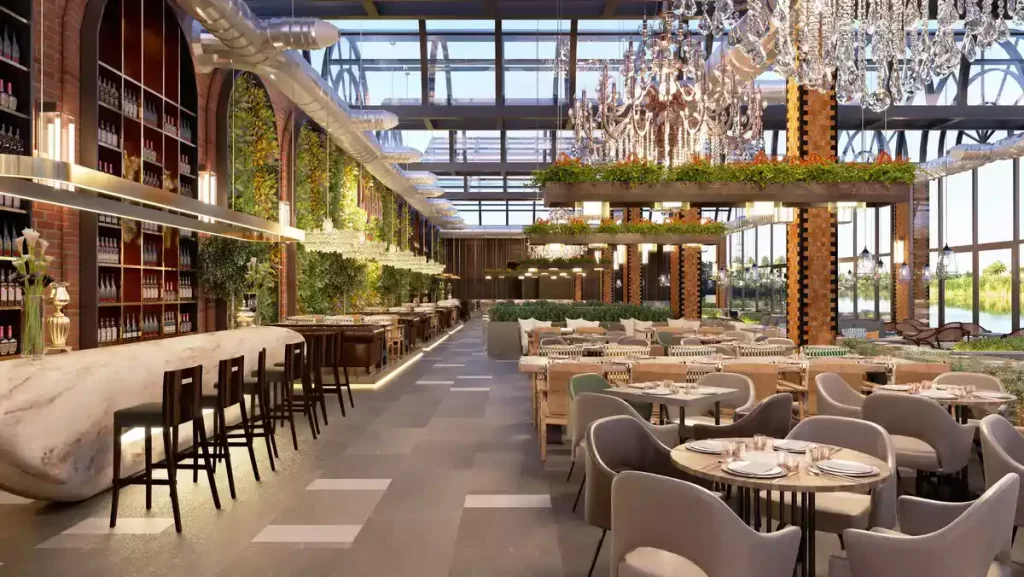
For instance: In a fine-dining restaurant, elegant aesthetics should never compromise the comfort of diners.
Plush chairs and well-spaced tables can maintain a luxurious atmosphere while ensuring a comfortable dining experience.
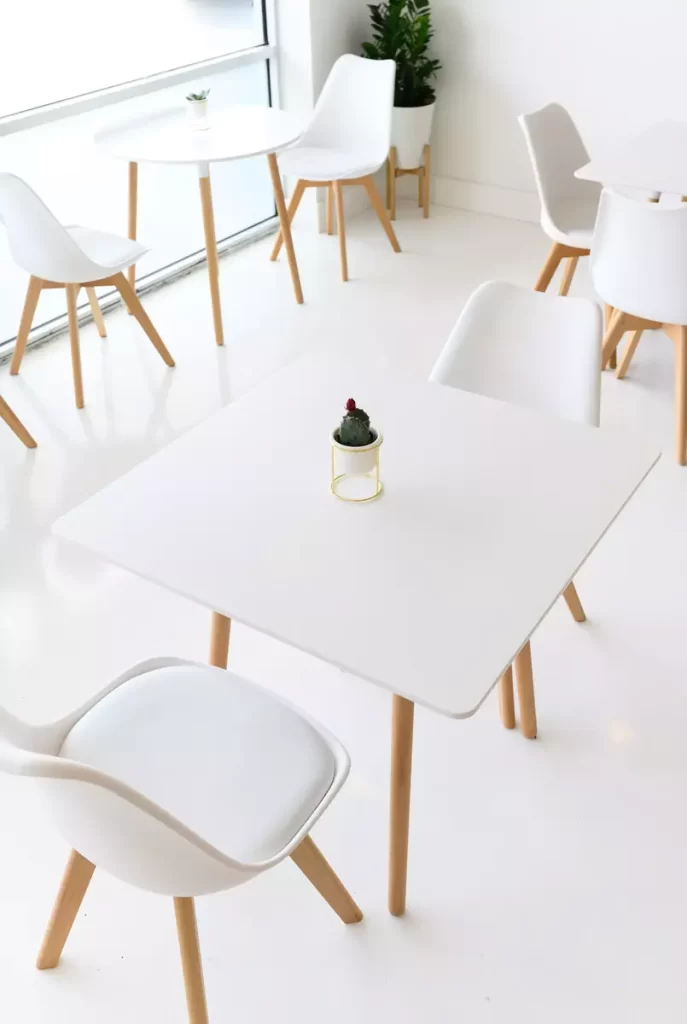
In a fast-casual eatery, the design should prioritize quick service and easy cleanup.
This might mean using durable, easy-to-clean materials for furniture and surfaces while incorporating an attractive, on-brand color scheme.
The Significance of Creating a Cohesive Theme and Concept.
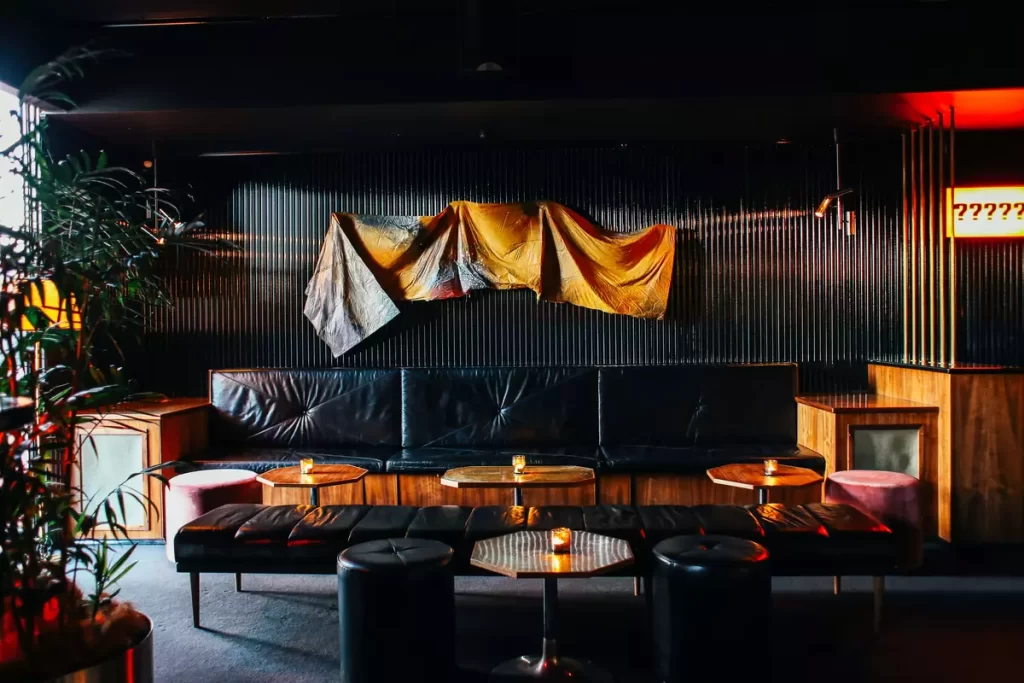
A cohesive theme ties the entire restaurant interior together, telling a story that resonates with diners.
This theme can be inspired by the cuisine, location, history, or a unique concept.

For Example, An Italian restaurant might embrace a Tuscan villa theme, with warm earthy tones, rustic wooden furniture, and vineyard-inspired decor elements.

Or A seafood restaurant near the coast could adopt a nautical theme, featuring shades of blue and white, rope accents, and maritime-inspired artwork.
A well-executed theme immerses diners in a memorable experience, making the restaurant’s interior design an integral part of their visit.
Restaurant Space Planning and Layout

Efficient space utilization is a cornerstone of effective restaurant interior design.
It’s the art of making every square foot count in a way that enhances the dining experience and maximizes the restaurant’s functionality.
Let’s delve into why this aspect is crucial, explore different restaurant layouts, and offer tips on optimizing seating arrangements based on the restaurant’s size.
Importance of Efficient Space Utilization
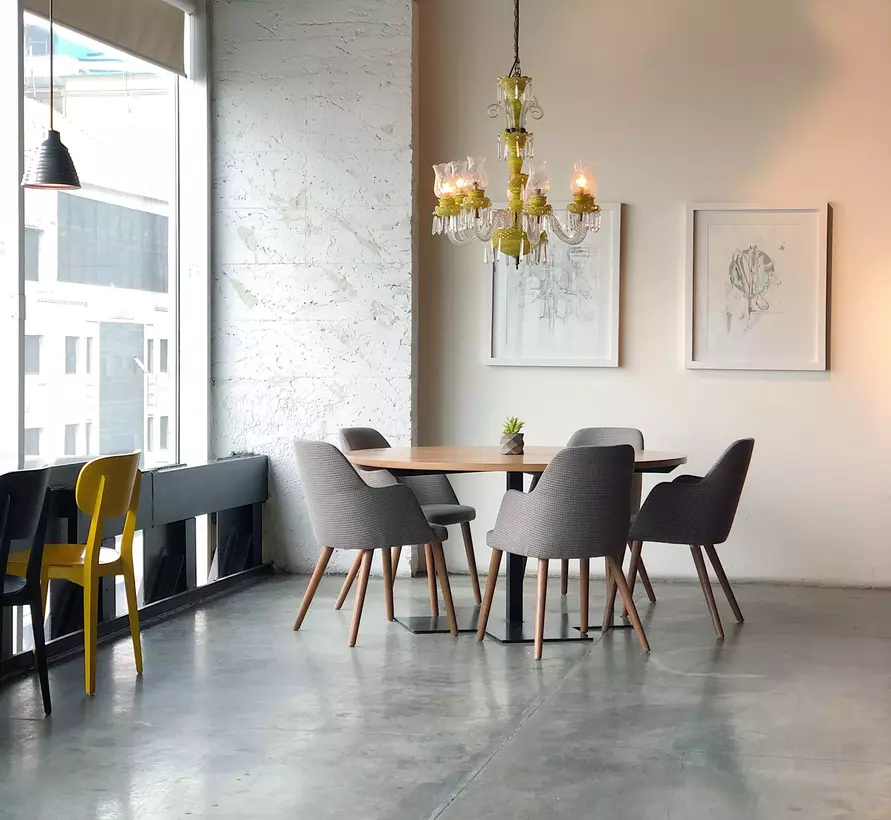
In restaurant interior design, space planning isn’t just about fitting tables and chairs; it’s about creating an environment that encourages comfort, flow, and profitability.
Efficient space utilization offers several benefits:
Enhanced Customer Experience: Ample space between tables prevents diners from feeling cramped, allowing them to converse comfortably.
Optimized Staff Efficiency: A well-designed layout minimizes server traffic and reduces the time it takes for staff to move between tables and the kitchen.
Increased Capacity: Smart space planning can increase the number of covers a restaurant can accommodate during peak hours, maximizing revenue potential.
Various Restaurant Layouts

Restaurant layouts can vary widely, each offering a distinct atmosphere and set of advantages.
Here are a few popular layouts:
Open Floor Plan: This design creates a spacious, communal dining area with minimal dividers, fostering a lively, social atmosphere.
It’s ideal for casual and family-friendly restaurants.
Booth Style: Booths provide a semi-private dining experience, often favored in upscale establishments.
They offer comfort and privacy for guests.
Bistro Layout: Characterized by small, closely spaced tables, this layout suits cozy, intimate settings.
It’s commonly found in cafes and small eateries.
Banquette Seating: Long, upholstered benches along walls with individual tables are often used to maximize space in smaller restaurants.
They offer a cozy, snug feeling.
Tips for Optimizing Seating Arrangements

Optimizing seating arrangements depends on the restaurant’s size and concept:
Small Restaurants: In compact spaces, maximize seating by using versatile furniture like stackable chairs and collapsible tables.
Consider a combination of bar seating, booths, and communal tables to offer variety.
Medium-sized Restaurants: Use a mix of seating options to cater to different group sizes.
Ensure there’s ample space between tables to maintain comfort and accessibility.
Large Restaurants: For spacious establishments, consider zoning areas based on the restaurant’s theme or cuisine.
Incorporate diverse seating options like private dining rooms, bar seating, and outdoor patios.
Flexibility is Key: Invest in movable partitions, such as screens or curtains, to adapt the layout for private events or varying crowd sizes.
Space planning and layout are fundamental aspects of restaurant interior design.
Efficient space utilization enhances the customer experience, staff efficiency, and overall profitability.
By carefully selecting a layout that suits the restaurant’s concept and optimizing seating arrangements accordingly, you can create a dining space that not only looks appealing but functions seamlessly, contributing to the restaurant’s success.
The Psychology of Colors and Lighting in Restaurant Interior Design

In restaurant interior design, the thoughtful selection of colors and lighting goes far beyond mere aesthetics; it profoundly influences the ambiance and patrons’ emotions.
Let’s dive into the psychology of colors, and the impact of lighting choices, and explore inspiring color and lighting combinations for various types of restaurants.
Psychology of Colors in Restaurant Interior Design

Colors hold the power to evoke specific emotions and appetites.
Understanding color psychology is essential in restaurant interior design:
Red: This bold color stimulates appetite and encourages social interaction.
It’s an excellent choice for vibrant, energetic settings, like a trendy urban bistro.
Blue: Blue has a calming effect and can reduce appetite.
However, it works well as an accent color in seafood restaurants, where it complements the maritime theme.
Yellow: Associated with happiness and warmth, yellow is often used in fast-food chains to convey a friendly and inviting atmosphere.
Green: Green is linked to health and tranquility.
It’s ideal for health-conscious eateries or vegetarian restaurants.
Neutral Tones: Beige, gray, and brown are versatile, creating a neutral backdrop that allows other design elements to shine.
They’re often used in fine dining establishments.
Lighting Choices and Their Effect on the Dining Atmosphere
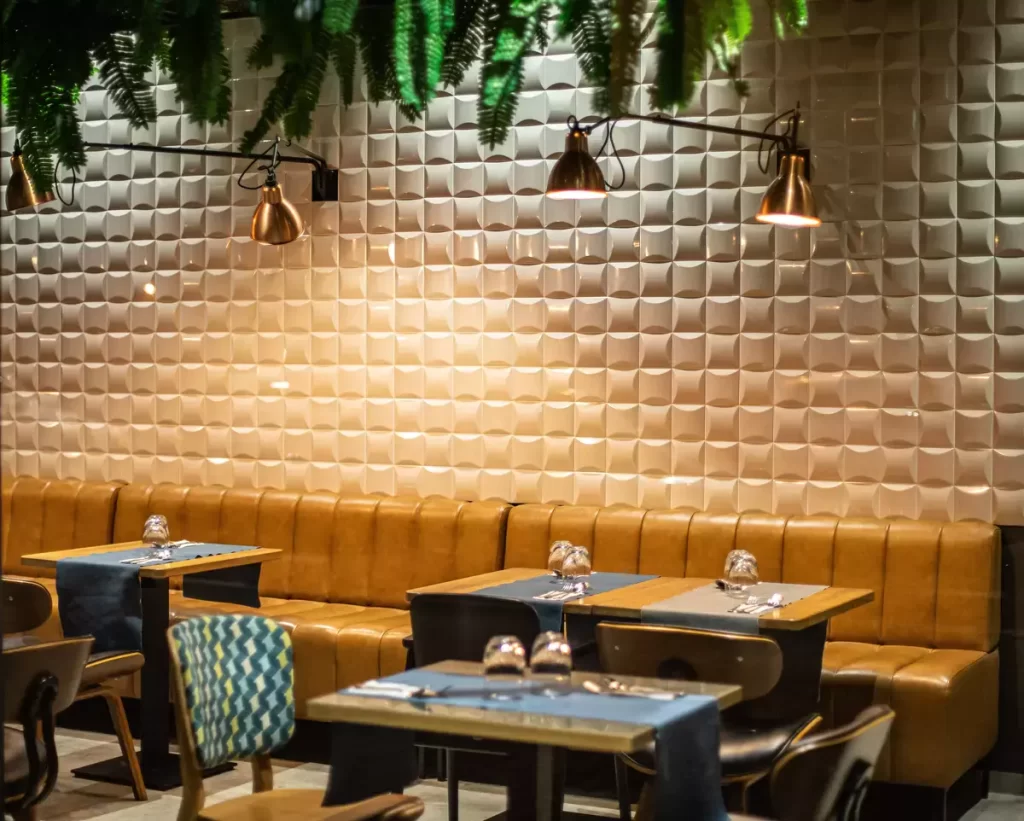
Lighting is crucial in setting the tone and improving the dining experience:
Warm vs. Cool Lighting: Warm lighting, such as soft yellow or amber hues, creates a cozy, intimate atmosphere.
Cool lighting, like white or blue tones, lends a modern and crisp feel.
Mix them thoughtfully to balance comfort and style.
Dimmers and Control Systems: Installing dimmer switches and control systems enables you to adjust lighting levels throughout the day, transitioning from a bright, welcoming ambiance during lunch to a more subdued, romantic setting in the evening.
Natural Light: Harnessing natural light through large windows or skylights can create a fresh and inviting daytime ambiance.
It’s especially beneficial for cafes and brunch spots.
Color and Lighting Combinations for Different Restaurants
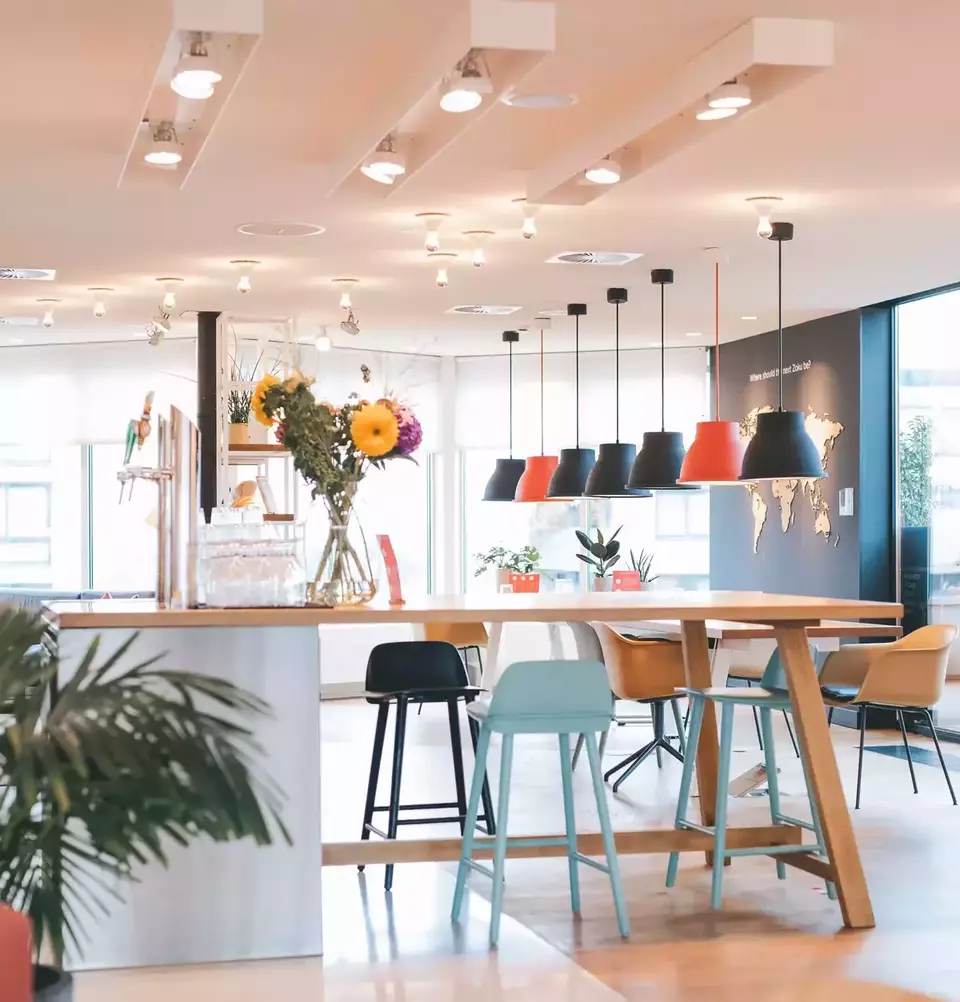
Consider these examples of color and lighting combinations tailored to different restaurant types:
Romantic Italian Restaurant: Deep reds and rich browns paired with soft, dimmed warm lighting create an intimate and romantic atmosphere.
Contemporary Sushi Bar: A minimalist palette of whites and neutrals, accentuated by cool blue or green lighting, conveys a modern, clean, and fresh vibe.
Family-Friendly Diner: Bright, cheerful primary colors combined with ample natural light foster a friendly, welcoming environment.
Health-conscious Café: Earthy greens and natural wood tones, complemented by soft, diffused natural light, promote a sense of well-being and relaxation.
Gourmet Steakhouse: A classic combination of dark wood interiors with warm, soft lighting provides a luxurious and timeless ambiance.
When tailored to the restaurant’s theme and concept, these elements can create a truly memorable dining experience.
Furniture and Décor Selection in Restaurant Interior Design

Selecting the right furniture and decor is a critical aspect of crafting a captivating and functional restaurant interior.
In this section, we’ll guide you through the process of choosing suitable restaurant furniture, elaborate on the role of decor in reinforcing the restaurant’s theme, and provide suggestions for sourcing unique and cost-effective decor items.
Choosing Appropriate Restaurant Furniture

Selecting restaurant furniture goes beyond aesthetics; it must align with the restaurant’s concept and cater to the comfort of your patrons:
Consider Durability: In a high-traffic environment, durability is paramount.
Opt for commercial-grade furniture made of robust materials like metal, hardwood, or laminate that can withstand constant use.
Comfort Matters: Comfortable seating is crucial for customer satisfaction.
Whether it’s classic wooden chairs, plush banquettes, or modern barstools, prioritize ergonomic design and ample padding.
Versatility and Flexibility: Choose furniture that can adapt to different group sizes and layouts.
Stackable chairs and modular seating arrangements offer versatility.
Material and Finish: The choice of materials and finishes should resonate with your restaurant’s theme.
For example, rustic wood complements a farm-to-table concept, while sleek metal suits a contemporary setting.
The Role of Décor in Reinforcing the Restaurant’s Theme

Decor is the soul of restaurant interior design, breathing life into the space and reinforcing its theme:
Articulate the Theme: Every decorative element, from wall art to table settings, should speak the language of your restaurant’s theme.
For instance, a Mediterranean restaurant could use mosaic tile accents and rustic pottery to evoke a Mediterranean coastal vibe.
Texture and Materials: Consistency in textures and materials enhances theme cohesion.
If your theme is industrial, incorporate exposed brick walls and metal accents throughout the decor.
Branding through Decor: Leverage decor to communicate your brand identity.
Custom signage, logo integration, and thematic décor elements can imprint your restaurant’s uniqueness on diners’ memories.
Functional Décor: Décor isn’t just about aesthetics; it should also serve practical purposes.
For instance, decorative room dividers can create intimate dining areas, enhancing the overall dining experience.
Creating a Memorable Entrance in Restaurant Interior Design

The entrance of a restaurant is more than just a doorway; it’s the threshold to a memorable dining experience.
In this section, we’ll underscore the importance of the restaurant’s entrance design, explore methods to leave a lasting first impression and highlight the crucial roles played by signage, doorways, and foyer areas.
The Significance of the Restaurant’s Entrance Design

The entrance design sets the tone for the entire dining experience, making it a focal point in restaurant interior design:
First Impressions Matter: Your restaurant’s entrance is the first point of contact for customers, offering an initial glimpse of the ambiance, style, and character of the establishment.
Brand Identity: The entrance serves as a visual representation of your restaurant’s brand, conveying its uniqueness and values.
Memorability: A well-designed entrance can leave a lasting impression on diners, encouraging them to return and recommend your restaurant to others.
Ways to Make a Lasting First Impression

To create a memorable entrance, consider the following strategies:
Captivating Visuals: Use eye-catching elements such as a striking color palette, decorative features, or artwork to draw attention and pique curiosity.
Lighting Magic: Thoughtful lighting can enhance the entrance’s ambiance.
Consider soft, warm lighting for an inviting atmosphere or dramatic lighting to create a sense of anticipation.
Focal Points: Incorporate a captivating focal point near the entrance, such as a grand chandelier, an impressive artwork piece, or a stunning hostess stand.
Seasonal Décor: Change decorations with the seasons or holidays to keep the entrance fresh and engaging, showcasing your restaurant’s adaptability.
The Role of Signage, Doorways, and Foyer Areas

Signage, doorways, and foyer areas play pivotal roles in crafting a remarkable entrance:
Striking Signage: Invest in distinctive and well-placed signage that reflects your restaurant’s branding and style.
It should be visible from a distance and easily recognizable.
Elegant Doorways: The design of the entrance door can set expectations.
A grand, ornate door might hint at a formal dining experience, while an open, airy entrance suggests a more casual atmosphere.
Functional Foyers: Foyer areas serve practical functions such as greeting guests, providing space for waiting, and controlling the indoor climate.
Ensure they are well-organized, comfortable, and in harmony with the restaurant’s overall design.
In restaurant interior design, the entrance holds the power to make a lasting first impression that lingers long after the meal is over.
By prioritizing design elements, captivating visuals, and thoughtful details in signage, doorways, and foyer areas, you can ensure that every guest’s journey begins with a memorable and enticing welcome.
The Dining Area in Restaurant Interior Design
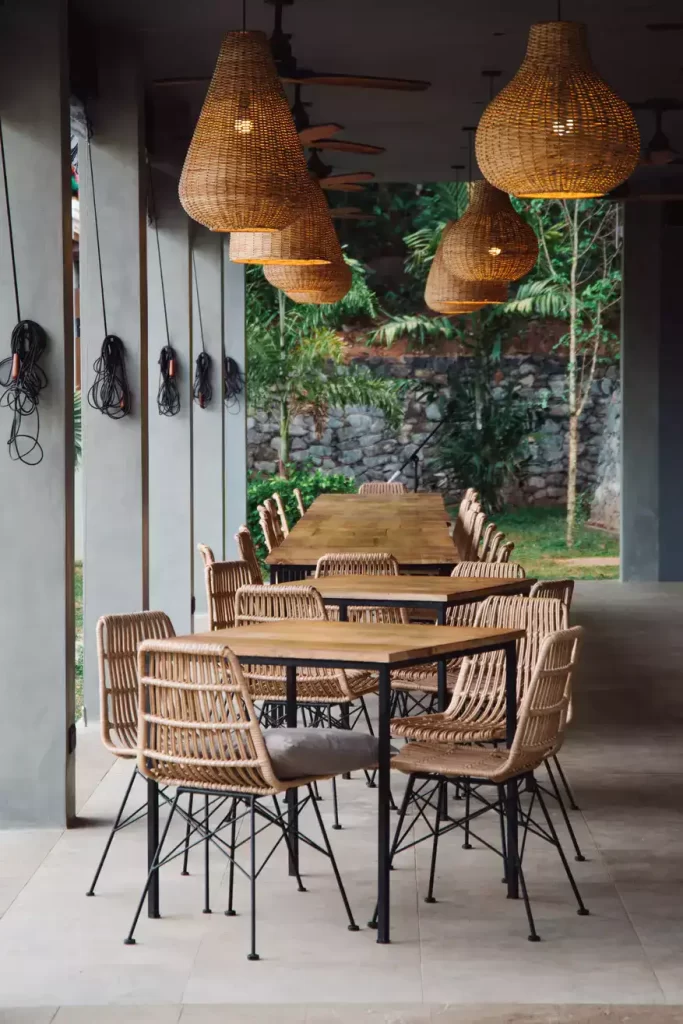
The dining area of a restaurant is where guests spend the majority of their time, making it a focal point in restaurant interior design.
In this section, we’ll explore options for restaurant table settings, emphasize the importance of comfort in chair selection, and provide insights into choosing tableware that complements the overall design.
Options for Restaurant Table Settings
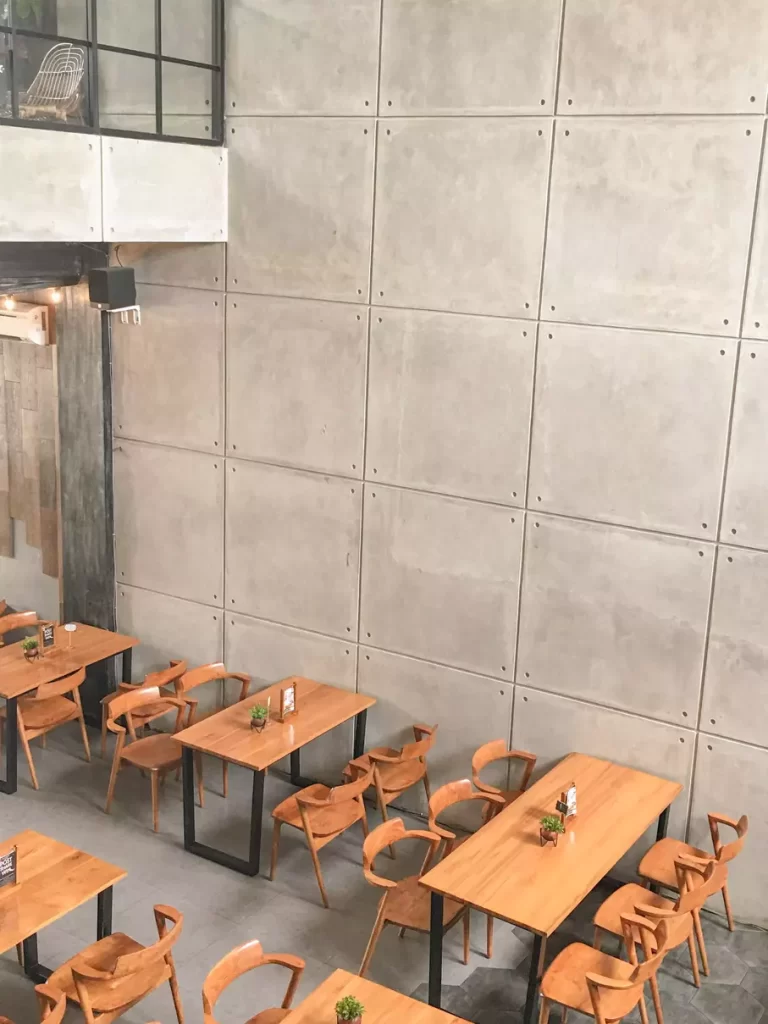
The choice of table settings can greatly influence the dining experience, from the type of tables to the arrangement of tableware:
Table Shapes: Consider the shape of tables that best suits your restaurant’s concept.
Round tables encourage social interaction, while rectangular tables are practical for accommodating larger groups.
Tabletop Materials: Select tabletop materials that align with your design and maintenance requirements.
Options range from wood, marble, and laminate to glass and metal.
Linens and Placemats: Linens and placemats add a layer of sophistication and can tie into your restaurant’s color scheme.
Crisp white tablecloths evoke elegance, while colorful placemats add vibrancy.
Centerpieces: Centerpieces, such as floral arrangements, candles, or artistic sculptures, can become focal points that enhance the dining experience and reinforce the restaurant’s theme.
The Importance of Comfort in Chair Selection
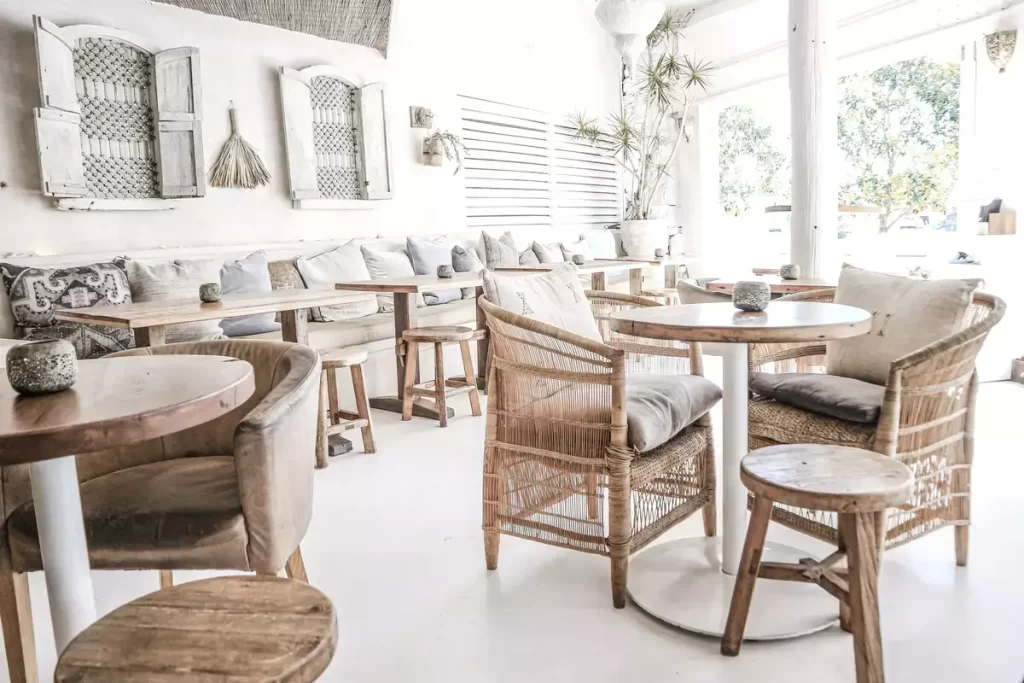
Comfortable seating is paramount in restaurant interior design.
Here’s why it matters:
Customer Satisfaction: Uncomfortable chairs can detract from the overall dining experience, leading to dissatisfaction and fewer return visits.
Extended Dining: Comfortable chairs encourage patrons to linger, which can lead to higher spending and increased table turnover.
Ergonomic Design: Consider chairs with proper lumbar support and cushioning, especially for long dining sessions.
Aesthetic Alignment: While comfort is crucial, chair design should also align with the restaurant’s theme and overall style.
Choosing Tableware that Complements the Design
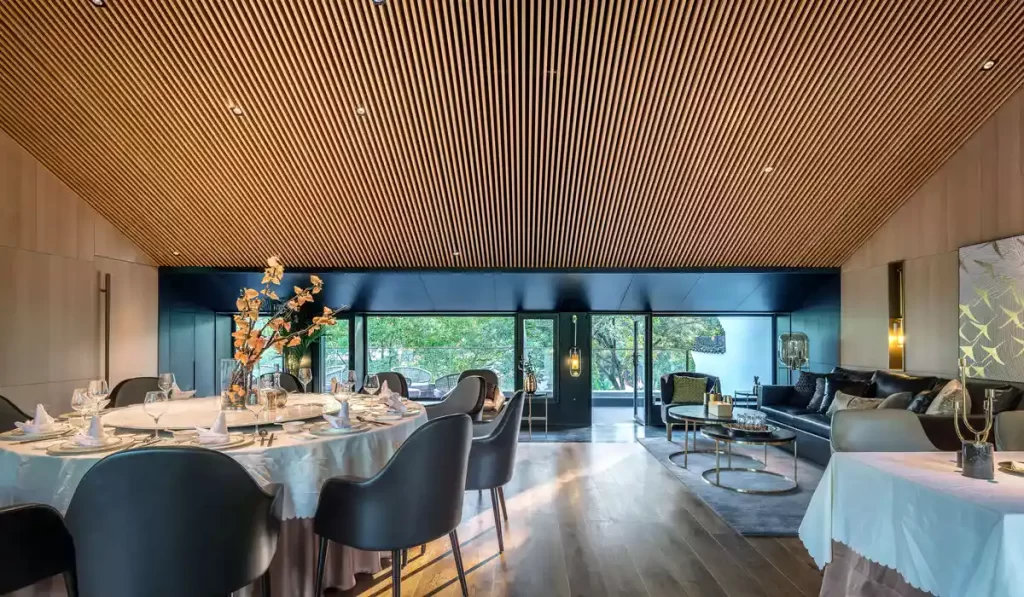
Tableware is an integral part of restaurant interior design, as it enhances the overall visual appeal and reinforces the restaurant’s identity:
Dishware and Cutlery: Consider the style of dishware and cutlery that harmonizes with your restaurant’s concept.
Fine china may be ideal for upscale dining, while rustic pottery suits a cozy bistro.
Glassware: The shape and quality of glassware can elevate the presentation of beverages.
Crystal glassware adds elegance, while stemless glasses convey a more casual vibe.
Table Accessories: Napkin holders, salt and pepper shakers, and condiment dispensers should complement the overall table setting and theme.
These small details contribute to the dining experience.
Branding: Use customized tableware with your restaurant’s logo or branding to reinforce your identity and make a lasting impression.
The Bar or counter in the Restaurant’s Interior Design

The bar is a central feature in many restaurants, offering patrons a place to unwind, socialize, and enjoy beverages.
Designing an inviting bar area is crucial to enhance the overall restaurant experience.
In this section, we’ll explore the key elements of bar design, including bar counter design, seating options, decor, and the integration of technology for entertainment.
Designing an Inviting Bar

Layout and Flow: The bar’s layout should promote a smooth flow of both customers and bartenders.
Consider the bar’s position within the restaurant to ensure it’s easily accessible yet doesn’t disrupt the dining area.
Lighting: Lighting is vital for creating ambiance.
Use warm, dimmable lighting to set a relaxed mood.
Consider pendant lights or under-counter lighting to highlight the bar area.
Materials and Texture: Select materials that are both functional and visually appealing.
For bar tops, materials like granite, wood, or marble are popular choices, providing durability and elegance.
Color Scheme: Choose colors that complement the overall restaurant interior design.
A harmonious color palette can tie the bar seamlessly into the restaurant’s theme.
Bar Counter Design, Seating Options, and Décor

Bar Counter Design: The bar counter should be functional and aesthetically pleasing.
Consider adding a foot rail for patron comfort and a mirrored or tiled backsplash to add depth and style.
Choose a design that suits your restaurant’s theme, whether it’s modern, industrial or rustic.
Seating Options: Bar seating should cater to a variety of preferences.
Offer a mix of barstools and high-top tables for individuals and groups.
Comfortable, well-padded barstools encourage patrons to linger.
Decor: Decorate the bar area to enhance its appeal.
Mirrors can make a small space feel larger, while artwork, shelving for juices display, and decorative glassware add character.
Incorporate thematic decor elements that align with your restaurant’s concept.
Bar Back: The bar back area, where bottles and tools are stored, can be an opportunity for design creativity.
Consider open shelving, custom cabinetry, or a stylish juice display that matches the overall aesthetic.
Integration of Technology for Entertainment
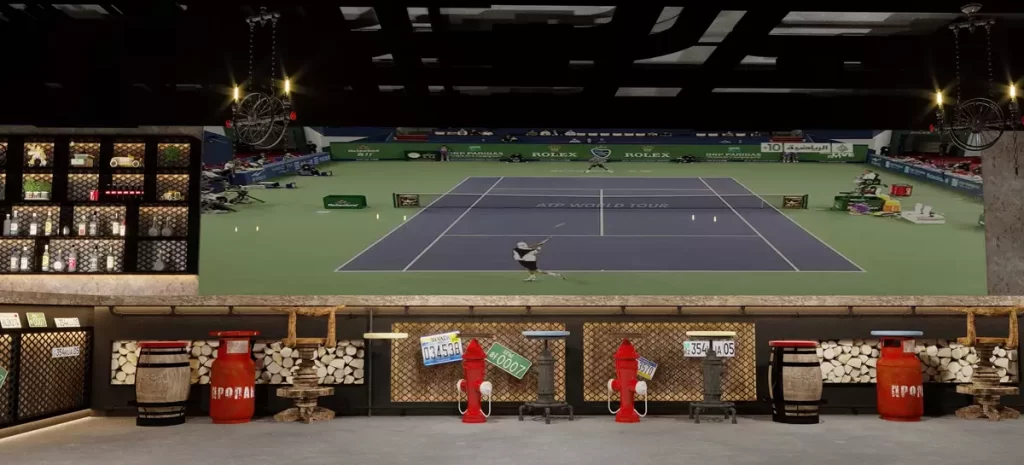
TV Screens: Strategically placed TV screens can offer sports or entertainment, attracting a specific clientele.
Ensure they’re positioned for clear visibility without disrupting the overall ambiance.
Sound System: Invest in a quality sound system to provide background music.
Make sure the volume is adjustable to suit the time of day and the mood you want to create.
Digital Menus: Embrace technology with digital menu boards or tablets for patrons to browse drink options.
It provides an interactive and modern touch.
Interactive Games: Some bars integrate touch-screen games or digital trivia, providing entertainment and encouraging longer stays.
In restaurant interior design, the bar area is a focal point that can significantly impact the overall experience.
By carefully designing the bar counter, selecting comfortable seating, enhancing décor, and integrating technology for entertainment, you can create an inviting and dynamic space that complements the restaurant’s theme and caters to a diverse range of patrons.
Kitchen and Service Areas in Restaurant Interior Design

While often hidden from the patrons’ view, the kitchen and service areas are the heartbeat of a restaurant.
In this section, we’ll briefly touch on the design aspects of restaurant kitchens, discuss the importance of efficient service areas, and highlight the critical need for safety and functionality in these spaces.
Design Aspects of Restaurant Kitchens

Layout Efficiency: The kitchen layout should prioritize workflow and efficiency.
The design should minimize the distance between prep areas, cooking stations, and serving areas to facilitate a smooth operation.
Ventilation and Exhaust: Adequate ventilation is essential for the comfort of kitchen staff and the removal of cooking odors.
Installing powerful exhaust systems and proper ventilation hoods is crucial.
Storage Solutions: Smart storage design is essential for keeping ingredients organized and accessible.
Utilize shelving, refrigeration units, and pantry space efficiently to minimize clutter.
Safety Considerations: Implement safety measures, such as fire suppression systems and non-slip flooring, to ensure the well-being of kitchen staff.
Efficient Service Areas

Order Management: An organized order management system is critical for efficient service.
Implement technology that streamlines orders from the dining area to the kitchen, reducing errors and wait times.
Server Stations: Design dedicated server stations near the kitchen for staff to pick up orders and refill beverages.
These areas should be well-stocked with necessary items like utensils, napkins, and condiments.
Customer Interaction: Efficient service areas should also consider the interaction between staff and patrons.
The design should encourage positive interactions while maintaining a smooth flow of service.
Safety and Functionality
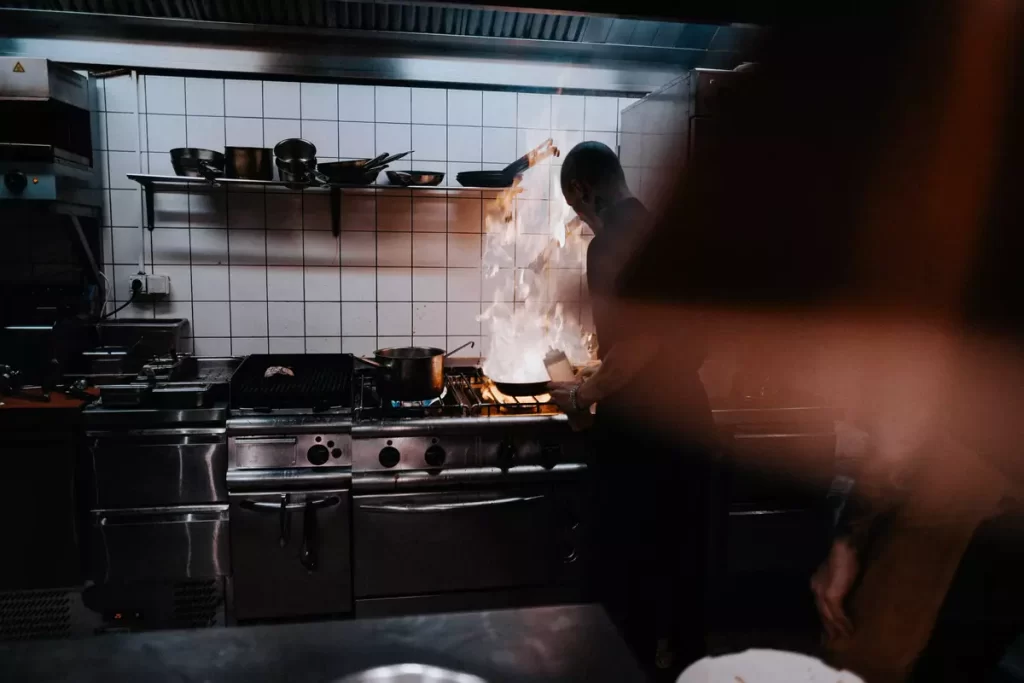
Food Safety: Maintaining food safety standards is non-negotiable in restaurant kitchens.
Design the kitchen to allow for safe food storage, handling, and cooking, with clear separation between raw and cooked foods.
Ergonomics: Consider the ergonomics of kitchen workstations to reduce staff fatigue and the risk of injuries.
Well-designed prep areas and equipment placement can make a significant difference.
Accessibility: Ensure that kitchen and service areas are accessible for all staff members.
This includes designing spaces that accommodate staff with disabilities.
Cleaning and Maintenance: The design should allow for easy cleaning and maintenance.
Select materials that are durable and easy to sanitize to maintain high hygiene standards.
For restaurant interior design, the kitchen and service areas are often the unsung heroes.
While patrons may not see them, the efficiency, safety, and functionality of these spaces directly impact the overall dining experience.
Budget-Friendly Tips for Restaurant Interior Design
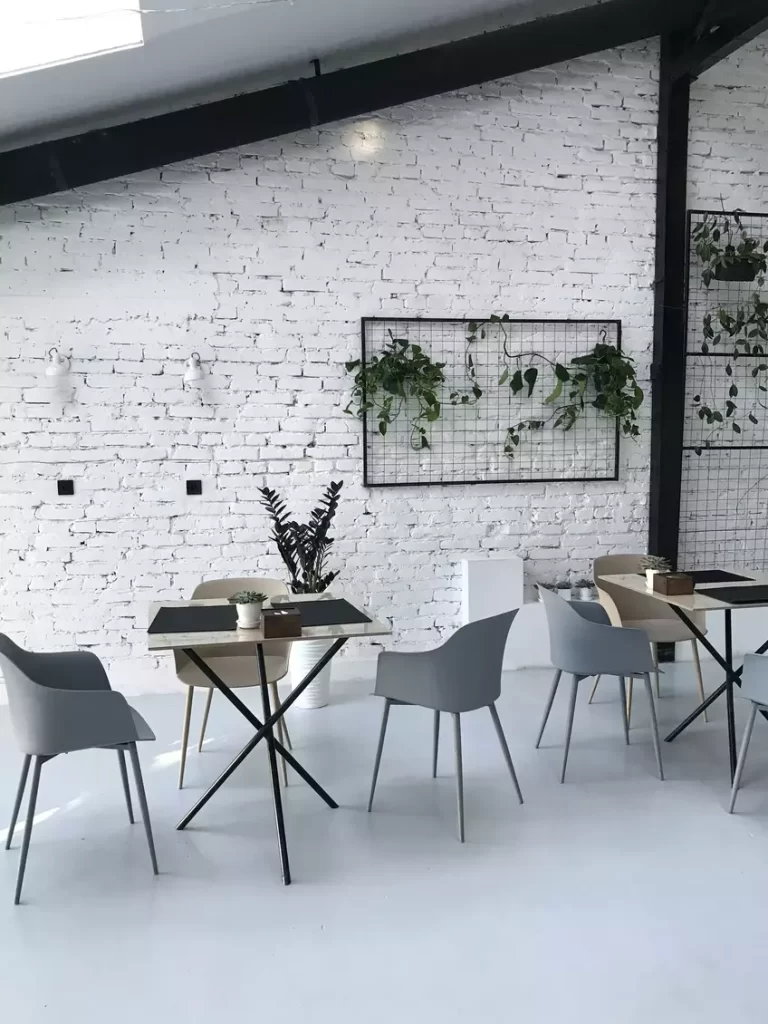
Designing a restaurant interior that is both visually appealing and cost-effective is a challenge that many restaurant owners face.
In this section, we’ll provide practical advice on cost-saving without compromising quality, suggest DIY and upcycling ideas for decor elements, and emphasize the importance of a well-defined budget.
Cost-Saving Tips Without Compromising Quality

Prioritize Essential Areas: Focus your budget on the most crucial areas that impact the overall dining experience, such as lighting, seating comfort, and high-traffic zones.
Allocating resources wisely can make a significant difference.
Second-Hand Furniture: Consider purchasing quality second-hand furniture for your restaurant.
Many businesses and auctions offer lightly used items at a fraction of the cost of new ones.
Local Artisans: Collaborate with local artisans and craftsmen for custom-made décor elements.
You can often get unique pieces at competitive prices while supporting local talent.
Flexible Seating: Invest in versatile seating options that can accommodate different group sizes and layouts.
This flexibility reduces the need for excessive furniture.
DIY and Upcycling Ideas for Décor Elements

Artwork: Create your own artwork or collaborate with local artists to design custom pieces.
Framing posters, maps, or vintage menus can also be a cost-effective way to decorate walls.
Upcycled Décor: Explore upcycling opportunities by repurposing items.
Old doors can become tabletops, wooden pallets can turn into shelves, and bottle crates can transform into decorative storage.
This not only saves money but also contributes to sustainability.
Do-It-Yourself Projects: Engage your creative side with DIY decor projects.
Craft decorative items like lampshades, coasters, or table centerpieces using affordable materials.
Thrift Store Finds: Visit thrift stores or flea markets for unique and budget-friendly decor items.
You may stumble upon vintage mirrors, eclectic dishware, or retro furniture that adds character to your restaurant.
The Importance of a Well-Defined Budget

Set Clear Priorities: Establish a budget that clearly outlines your spending limits for each aspect of restaurant interior design.
Determine your top priorities and budget accordingly.
Stick to the Budget: Discipline is key. Once you’ve set a budget, adhere to it as closely as possible.
Avoid impulsive purchases that can lead to overspending.
Consult Experts: Consider seeking guidance from a professional interior designer who can help you make informed decisions within your budget constraints.
Their expertise can be invaluable in maximizing your budget’s impact.
Regular Review: Continuously review and adjust your budget as the project progresses.
Be prepared to adapt to unexpected costs or find savings in other areas.
In restaurant interior design, cost-effectiveness is about making the most of your resources while maintaining quality and style.
By implementing these budget-friendly tips, engaging in DIY and upcycling projects, and adhering to a well-defined budget, you can create an inviting and unique restaurant space without breaking the bank.
Get Inspired By Some of Our Restaurant Designs
In conclusion, restaurant interior design is a powerful tool for creating unforgettable dining experiences.
From theme consistency to efficient space utilization, lighting, fusion concepts, and interactive elements, these principles shape the ambiance that patrons remember.
Prioritizing thoughtful design can boost customer satisfaction and drive business success.
Engage our services in seasoned interior design to transform your restaurant’s distinct vision into a remarkable culinary destination, guaranteeing its prominence in the industry
Your investment in design will yield lasting rewards for both you and your patrons.

